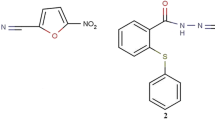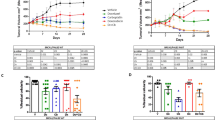Summary
A series of isomeric [1,2-bis(difluorophenyl) ethylenediamine]dichloroplatinum(II) complexes and cisplatin were tested on the P388 leukemia and on the murine hormone-independent MXT (M3.2) OVEX and the ovarian — hormone — dependent MXT (M3.2) mammary carcinoma for evaluating antineoplastic activity against breast cancer in vivo. Although these results were heterogeneous, a trend to the 2,6-difiuorosubstituted compound as the most active platinum complex was observed. For the development of a large-scale in vitro screening method on human breast cancer cell lines, cell number, [3H]thymidine incorporation, and crystal violet staining were evaluated as parameters for end-point determination. Chemosensitivity testing on the human breast cancer cell lines MDA-MB-231 and MCF-7 unam-biguously identified [1,2-bis(2,4-difluorophenyl)ethyle-nediamine]dichloroplatinum(II) as the complex with the highest activity in the crystal violet micro-assay. In equimolar concentration this compound was superior to cisplatin on both cell lines. The analysis of the conflicting results of this study indicates that murine mammary carcinomas are most probably unrealistic and inappropriate models for the screening of cytotoxic platinum complexes with potential activity on human breast cancer.
Similar content being viewed by others
Abbreviations
- PBS:
-
phosphate-buffered saline
- PEG:
-
polyethlyeneglycol
References
Angerer Ev, Birnböck H, Knebel N (1989) Platinum complexes with a selective action on estrogen receptor-positive mammary tumors. Anti-Cancer Drug Design 4:21
Birnböck H (1988) Untersuchungen zur Pharmakokinetik des Zindoxifens und zur Wirkung von Inhibitoren der Steroidsulfatase an hormonabhÄngigen Tumoren. Dissertation, Regensburg
Cailleau R, Young R, Olivé M, Reeves WJ (1974) Breast tumor cell lines from pleural effusions. J Natl Cancer Inst 53:661
Chabner BA (1990) In defense of cell-line screening. J Natl Cancer Inst 82:1083
Danguy A, Kiss R, Leclerq G, Heuson C, Pasteels JL (1986) Morphology of MXT mouse mammary tumors. Correlation with growth characteristics and hormone sensitivity. Eur J Clin Oncol 22:69
Dawe CJ, Potter M (1957) Lymphocytic leukemia P 388 of the DBA/2 mouse. Am J Pathol 33:603
Driscoll JS (1984) The preclinical drug research program of the National Cancer Institute. Cancer Treat Rep 68:63
Gillies RJ, Didier N, Denton M (1986) Determination of cell number in monolayer cultures. Anal Biochem 159:109
Goldin A, Venditti JM, Humphreys SR, Mantel N (1958) Quantitative evaluation of chemotherapeutic agents against advanced leukemia in mice. J Natl Cancer Inst 21:495
Johnson KJ (1990) Screening methods in antineoplastic drug discovery. J Natl Cancer Inst 82:1082
Kerkvliet GJ (1990) Drug discovery screen adapts to changes. J Natl Cancer Inst. 82:1087
Müller R, Gust R, Jennerwein M, Reile H, Laske R, Krischke W, Bernhardt G, Spru\ Th, Engel J, Schönenberger H (1989) Tumor Inhibiting [1,2-bis(fluorophenyl-ethylenediamine]platinum-(II) Complexes. Part I: Synthesis. Eur J Med Chem 24:341
Müller R, Schickaneder E, Jennerwein M, Reile H, Spru\ Th, Engel J, Schönenberger H (1991) Tumor inhibiting [1,2-bis(difluoro-phenyl)ethylenediamine]dichloroplatinum(II) complexes: part I. Synthesis. Arch Pharm (Weinheim) 324:115
Orde HD vom, Reile H, Müller R, Gust R, Bernhardt G, Spru\ Th, Schönenberger H, Burgemeister T, Mannschreck A (1990) Tumor Inhibiting [1,2-bis(fluorophenyl)ethylenediamine]platinum-(II) complexes: V. Synthesis and evaluation of enantiomeric [1,2-bis-(4-fluorophenyl)ethylenediamine]dichloroplatinum(II) complexes. J Cancer Res Clin Oncol 116:434
Reile H, Müller R, Gust R, Laske R, Krischke W, Bernhardt G, Spru\ Th, Jennerwein M, Engel J, Seeber S, Osieka R, Schönenberger H (1990a) Tumor inhibiting [1,2-bis(fluorophenyl)ethyl-enediamine]platinim(II) complexes: part II. Biological evaluation — in vitro studies on the P 388 D1 leukemia cell line. Arch Pharm (Weinheim) 323:133
Reile H, Spru\ Th, Müller R, Gust R, Bernhardt G, Schönenberger H, Engel J (1990b) Tumor inhibiting [1,2-bis(fluorophenyl)eth-ylenediamine]dichloroplatin(II) complexes (III). Evaluation of mammary tumor inhibiting properties. Arch Pharm (Weinheim) 323:301
Schneider MR, Ball H, Schönenberger H (1985) Acetoxy substituted 1,1,2-triphenylbut-1-enes with antiestrogenic and mammary tumor inhibiting properties. J Med Chem 28:1880
Schneider MR, Michna H, Nishino Y, El Etreby MF (1989) Antitumor activity of the progesterone antagonists ZK 98.299 and RU 38.486 in the hormone-dependent MXT mammary tumor model of the mouse and the DMBA- and MNU-induced mammary tumor models of the rat. Eur J Cancer Clin Oncol 25:691
Schönenberger H, Kranzfelder G, Hoffmann E, Egginger G, Schmitt H, Taneja AK (1976) Experimentelle Chemotherapie des Mammakrebses. Pharmazie 31:590
Schönenberger H, Gust R, Karl J, Spru\ Th, Schneider MR, Hartmann RW, Batzl Ch, Schertl S, Engel J, Lux F, Trebert-Haeberlin S (1989) Rezeptorgebundene Chemotherapie in Antiöstrogene in Forschung und Klinik, Reihe Aktuelle Onkologie 46, Zuckschwerdt Verlag, München
Silvestrini R, Sanfilippo O, Daidone MG (1983) In: Dendy PP, Hill BT (eds) Human tumor drug sensitivity testing in vitro. Academic Press, New York, p 281
Soule HD, Varques J, Long A, Albert S, Brennan MJ (1973) A human cell line from a pleural effusion derived from a breast carcinoma. J Natl Cancer Inst 51:1409
Staquet MJ, Byar DP, Green SB, Rozenczweig M (1983) Clinical predictivity of transplantable tumor systems in the selection of new drugs for solid tumors: rationale for a three-stage strategy. Cancer Treat Rep 67:753
Watson C, Medina D, Clark JH (1977) Estrogen receptor characterization in a transplantable mouse mammary tumor. Cancer Res 37:3344
Watson C, Medina D, Clark JH (1980) Characterization of progesterone receptors, estrogen receptors, and estrogen (type II)-binding sites in the hormone-independent variant of the MXT-3590 mouse mammary tumor. Endocrinology 107:1432
Wilson AP (1986) Cytotoxicity and viability assays. In: Freshney RI (ed) Animal cell culture: a practical approach. IRL, Eynsham, p 194
Author information
Authors and Affiliations
Additional information
Dedicated to Professor Franz Lux on the occasion of his 65th birthday
Rights and permissions
About this article
Cite this article
Spru\, T., Bernhardt, G., Schickaneder, E. et al. Different response of murine and human mammary tumour models to a series of diastereoisomeric [1,2-bis(difluorophenyl) ethylenediamine]dichloroplatinum(II) complexes. J Cancer Res Clin Oncol 117, 435–443 (1991). https://doi.org/10.1007/BF01612764
Received:
Accepted:
Issue Date:
DOI: https://doi.org/10.1007/BF01612764




